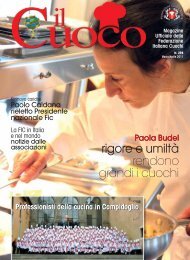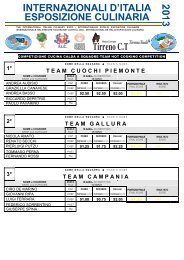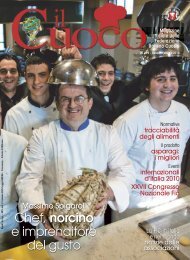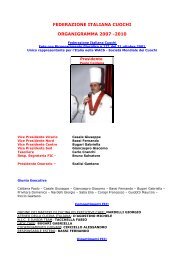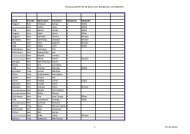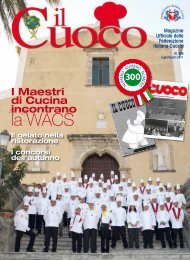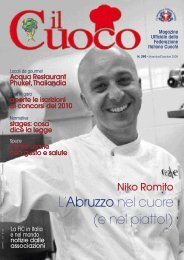Scarica versione PDF - Federazione Italiana Cuochi
Scarica versione PDF - Federazione Italiana Cuochi
Scarica versione PDF - Federazione Italiana Cuochi
You also want an ePaper? Increase the reach of your titles
YUMPU automatically turns print PDFs into web optimized ePapers that Google loves.
ILCUOCOINTERNATIONAL<br />
was awarded in 1996 and 2007. “His was an<br />
immediately successful career which began<br />
when he was young and gained experience<br />
from famous international chefs, such as<br />
Gualtiero Marchesi and George Blanc. The<br />
success he obtained has not changed his retiring<br />
nature: however, he spends most of the<br />
day in the kitchen, from first thing in the<br />
morning until late at night. Here, in his<br />
realm, Alfonso thinks, creates, experiments,<br />
tries and has fun. He works close to the sea<br />
and has a very close relationship with the sea:<br />
he prefers cooking with fresh fish, trying to<br />
handle it as little as possible and always with<br />
maximum delicacy, from large lobsters and<br />
crayfish to humble shellfish, such as the carnume,<br />
rich in iodine and with a tempting smell.<br />
He often leaves the head and tail in the<br />
plate to show the type and freshness. He uses<br />
every part of the fish, including the bits<br />
that are usually thrown away, to produce<br />
gravies, sauces and decorations, trying to perfect<br />
each of his productions”. These are the<br />
first words of the book “Alfonso Caputo. Il<br />
Gusto del mare alla Taverna del Capitano”<br />
(The Taste of the sea at the Taverna del Capitano)”<br />
(Ed. Gribaudo - Il Gusto 2010) and<br />
he introduces the reader to discovering his<br />
cuisine which is “clear, breezy, but always uncompromising<br />
on the quality of the raw<br />
materials. His presentations may be simple<br />
and linear, or inventive and exuberant, full<br />
of colour and structure: in all cases they are<br />
the result of perfect, cutting-edge craftsmanship,<br />
in which the gratification of the eye<br />
is equal to the pleasure of the palate”.<br />
78|<br />
SEE PAGE 34<br />
FOR THE ITALIAN TEXT<br />
Fruit:<br />
beautiful,<br />
fine and health<br />
by Michele D’Agostino<br />
Maestro di cucina and<br />
executive chef, teaching<br />
and gastronomy coordinator for the<br />
Fic Ateneo della Cucina <strong>Italiana</strong><br />
Fruit is a fundamental food in man’s diet and<br />
a versatile ingredient, also increasingly popular<br />
in the recipes of chefs. When fresh, it always<br />
gives the best of itself, even when, in the hands<br />
of skilful carvers, it transforms itself into a<br />
work of art, like the watermelon in the photos<br />
of these pages.<br />
Because of its complete, harmonic and balanced<br />
nutritional principles, fruit is the<br />
food of choice for man; it is pure and the<br />
most suitable for sustaining the human<br />
body and mind. Food which, according to the<br />
law of minimum energy and digestion expenditure,<br />
is the most appropriate for the human<br />
species, structured morphologically,<br />
anatomically and biologically to gather and<br />
eat fruit.<br />
Comparative anatomy confirms that human<br />
teeth, stomach, digestive gastric juices<br />
and the digestive system are built so that man<br />
can feed himself almost exclusively on fruit.<br />
In ancient times, fruit was considered an<br />
almost sacred food, the scriptures, especially,<br />
are full of tales and parables in which fruit<br />
is considered the symbol of richness, abundance,<br />
health and good fortune: cornucopias<br />
overflowed with fruit. According to<br />
the Bible, man was destined to be a gardener,<br />
a cultivator and not a breeder and when<br />
he forgot his mission, diseases and early<br />
death developed. Fruit was considered the<br />
most desirable food to the point that it was<br />
symbolically the cause of man’s being driven<br />
out of terrestrial paradise. Mohammed<br />
loved eating figs so much that he wished to<br />
take them with him to paradise. In ancient<br />
Egypt, too, the grape, especially, was held in<br />
great esteem. The pagans consecrated the olive<br />
to Minerva, the date to the Muses and the<br />
fig and the grape to Bacchus, to obtain<br />
their protection.<br />
THE FOUR CATEGORIES<br />
Fruit can be divided into 4 basic groups:<br />
A (juicy fruit); B (walnuts, almonds, etc.); C<br />
(cereals); D (pulses). Group A constitutes the<br />
fleshy part which surrounds the seed of<br />
part B. These two groups constitute our real<br />
nutriment because they can be eaten directly,<br />
in the natural state, i.e. raw, while the<br />
foods which constitute group C and D in<br />
some ways have to be prepared. These last two<br />
groups in actual fact are substitutes which<br />
man has used since ancient times mainly<br />
when fresh fruit was no longer available due<br />
to climatic factors. In actual fact it is more<br />
a need for variety than real nutritional needs<br />
which forces man to eat groups C and D. The<br />
fruit in group A contains everything our organism<br />
needs to repair and keep our tissues<br />
and vital functions in top condition because<br />
it provides the organism with energy<br />
in the form of sugars and, at the same time,<br />
cleans it of accumulated waste. The fruits in<br />
group B, even if they are not necessary, are<br />
useful because they help the body to store energy<br />
in the form of fats.<br />
Enzymes are synonymous with life and are<br />
at their maximum expression in fresh, ripe<br />
fruit. Each food in its raw state contains enzymes<br />
which are associated to those already<br />
present in our digestive system for the purpose<br />
of breaking down the foods to assimilate<br />
the nutrients they contain.<br />
A HEALTHY CHOICE<br />
Fruit contains: distilled biological water,<br />
enzymes, organic mineral salts, balanced<br />
and easy to assimilate non-heme iron, Axons<br />
or growth factors, proteins in balanced<br />
amounts, enough to satisfy human needs,<br />
Omega 3 containing positive type I and III<br />
prostaglandins, hormones capable of regularising<br />
and slowing down the absorption of<br />
glucose in the intestine, anti-oxidants which<br />
reduce free radicals and diseases, alkalizing<br />
products, a barrier against osteoporosis, fibres,<br />
bioflavonoid, molecules, which are<br />
found exclusively in fruit and vegetables<br />
and carry out powerful protective actions on<br />
the various internal organs of our body, A,<br />
B1, B2, C and PP. Fruit is highly purifying,<br />
good for constipation and slimming. Also<br />
fruit is without saturated fats and has a<br />
detoxifying power. Many fruits in our geographical<br />
area do not require chemical treatments<br />
and are naturally organic: figs, Indian<br />
figs, persimmons, pomegranates, arbutus<br />
berries, mixed berries, sorb apples, wild strawberries,<br />
Neapolitan medlars, carobs,<br />
raspberries, jujubes, mulberries, blackberries,<br />
tangerines, clementines and blueberries.<br />
AN APPLE A DAY<br />
Apples deserve a special mention: they are<br />
the richest in the less harmful sugar, fructose,<br />
which does not cause diabetes nor a reduction<br />
of hormones. In fact, apples have 6 parts<br />
of fructose to one part of glucose and saccharine,<br />
while other fruits have about the<br />
same amounts of fructose, glucose and saccharine.<br />
Only grapes and cherries have 6% of<br />
fructose, but also a high content of glucose<br />
and saccharine. Apples have the highest<br />
content of pectins compared with all other<br />
fruits, substances able to reduce the intestinal<br />
bacteria content by carrying out a preventive<br />
healing action against arthrites. The advantage<br />
of containing a high quantity of fructose<br />
and a low quantity of other sugars is considerable:<br />
the other sugars encourage the formation<br />
of triglycerides which together with




